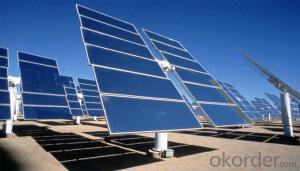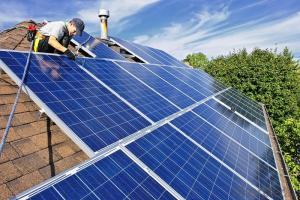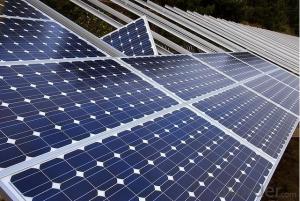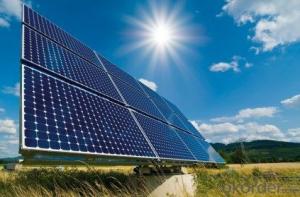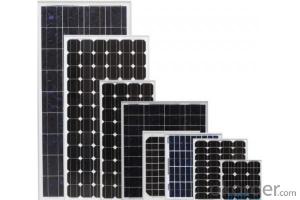Sun Power Solar Panels - Solar Module9
- Loading Port:
- China Main Port
- Payment Terms:
- TT OR LC
- Min Order Qty:
- -
- Supply Capability:
- -
OKorder Service Pledge
OKorder Financial Service
You Might Also Like
Solar Module
ABOUT YINGLI GREEN ENERGY
Yingli Green Energy Holding Company Limited (NYSE: YGE) is one of
the world’s largest fully vertically integrated PV manufacturers, which
markets its products under the brand “Yingli Solar“. With over 7.0GW
of modules installed globally, we are a leading solar energy company
built upon proven product reliability and sustainable performance. We
are the fi rst renewable energy company and the fi rst Chinese company
to sponsor the FIFA World CupTM.
PERFORMANCE
- High effi ciency, multicrystalline silicon solar cells with high transmission
and textured glass deliver a module effi ciency of up to 16.0%,
minimizing installation costs and maximizing the kWh output of your
system per unit area.
- Tight positive power tolerance of 0W to +5W ensures you receive
modules at or above nameplate power and contributes to minimizing
module mismatch losses leading to improved system yield.
- Top ranking in the “TÜV Rheinland Energy Yield Test” and the
“PHOTON Test” demonstrates high performance and annual energy
production.
RELIABILITY
- Tests by independent laboratories prove that Yingli Solar modules:
Fully conform to certifi cation and regulatory standards.
Withstand wind loads of up to 2.4kPa and snow loads of up to
5.4kPa, confi rming mechanical stability.
Successfully endure ammonia and salt-mist exposure at the highest
severity level, ensuring their performance in adverse conditions.
- Manufacturing facility certifi ed by TÜV Rheinland to ISO 9001:2008,
ISO 14001:2004 and BS OHSAS 18001:2007.
WARRANTIES
- 10-year limited product warranty1.
- Limited power warranty1: 10 years at 91.2% of the minimal rated power
output, 25 years at 80.7% of the minimal rated power output.
1In compliance with our Warranty Terms and Conditions.
QUALIFICATIONS & CERTIFICATES
IEC 61215, IEC 61730, MCS, CE, ISO 9001:2008, ISO 14001:2004, BS OHSAS
18001:2007, PV Cycle, SA 8000
ELECTRICAL PERFORMANCE
Electrical parameters at Standard Test Conditions (STC)
Module type YLxxxP-29b (xxx=Pmax)
Power output Pmax W 260 255 250 245 240
Power output tolerances ΔPmax W 0 / + 5
Module effi ciency ηm % 16.0 15.7 15.4 15.1 14.8
Voltage at Pmax Vmpp V 30.3 30.0 29.8 29.6 29.3
Current at Pmax Impp A 8.59 8.49 8.39 8.28 8.18
Open-circuit voltage Voc V 37.7 37.7 37.6 37.5 37.5
Short-circuit current Isc A 9.09 9.01 8.92 8.83 8.75
Electrical parameters at Nominal Operating Cell Temperature (NOCT)
Power output Pmax W 189.7 186.0 182.4 178.7 175.1
Voltage at Pmax Vmpp V 27.6 27.4 27.2 27.0 26.8
Current at Pmax Impp A 6.87 6.79 6.71 6.62 6.54
Open-circuit voltage Voc V 34.8 34.8 34.7 34.6 34.6
Short-circuit current Isc A 7.35 7.28 7.21 7.14 7.07
STC: 1000W/m2 irradiance, 25°C cell temperature, AM1.5g spectrum according to EN 60904-3.
Average relative effi ciency reduction of 3.3% at 200W/m2 according to EN 60904-1.
NOCT: open-circuit module operation temperature at 800W/m2 irradiance, 20°C ambient temperature, 1m/s wind speed.
OPERATING CONDITIONS
Max. system voltage 1000VDC
Max. series fuse rating 15A
Limiting reverse current 15A
Operating temperature range -40°C to 85°C
Max. static load, front (e.g., snow) 5400Pa
Max. static load, back (e.g., wind) 2400Pa
Max. hailstone impact (diameter / velocity) 25mm / 23m/s
CONSTRUCTION MATERIALS
Front cover (material / thickness) low-iron tempered glass / 3.2mm
Cell (quantity / material / dimensions /
number of busbars)
60 / multicrystalline silicon / 156mm x 156mm / 2 or 3
Encapsulant (material) ethylene vinyl acetate (EVA)
Frame (material / color / anodization color /
edge sealing) anodized aluminum alloy / silver / clear / silicone or tape
Junction box (protection degree) ≥ IP65
Cable (length / cross-sectional area) 1000mm / 4mm2
Plug connector
(type / protection degree) MC4 / IP67 or YT08-1 / IP67 or Amphenol H4 / IP68
PACKAGING SPECIFICATIONS
Number of modules per pallet 29
Number of pallets per 40' container 28
Packaging box dimensions
(L / W / H) 1700mm / 1135mm / 1165mm
Box weight 568kg
Unit: mm
• Due to continuous innovation, research and product improvement, the specifi cations in this product information sheet are subject to change
without prior notice. The specifi cations may deviate slightly and are not guaranteed.
• The data do not refer to a single module and they are not part of the offer, they only serve for comparison to different module types
- Q: I have a cabin that is way out in the middle of no where, it would cost 000's of dollars to get power to it. If I have a 8,000 BTU air conditioner that runs on 25 volts and 5 amps (or 875 watts)How many solar panels will I need to run this during the day, plus charge the batteries to run it all night? How many batteries would I need
- You are probably going to need about 60 panles and 60 batteries....you will also need a very good power inverter. Also consider the power it takes to invert 2 volt DC battery power in to 20 volts AC power required for an air conditioner. You might consider also trying to find a 2 or a 24 volt unit cooler. You would be better off buying a generator. Solar panels and batteries are not going to run an air conditioner for long if at all.....it might be cheaper to have the power company run the power.
- Q: Got a quote for about $K today for solar panels to save me about $00 a month on my electric bill. I was just wondering if anyone had successfully bought and installed their own and how it worked for you?
- Homemade okorder /
- Q: I was trying to figure out if I could run an electric heater off of a solar panel, but I don't understand these electric convertion factors and stuff. Would it work? (I know it'll only work in the daytime and stuff.)SOLAR PANELPeak Power 95W PTC Watts 73.0WVoc 30.7VPeak Voltage 24.4VIsc 8.6APeak Current 7.96A HEATERInput: 20 V/60 Hz ,500 W/5,200 BTU
- the panel would have to be on for 0 hours in the sun to get an hours use with the set up. try researching solar hot water heaters. they are much more efficient. a cheap one would be painting an old hot water heater black and pipe it to the new hot water heater. it will save you 80% of your electric hot water bill.
- Q: Can solar panels be used in areas with high levels of pollution from industrial activities?
- Yes, solar panels can be used in areas with high levels of pollution from industrial activities. While pollution can have some impact on the efficiency of solar panels, they are still able to generate electricity even in polluted areas. Regular cleaning and maintenance of the panels may be required to ensure optimal performance. Additionally, installing solar panels in such areas can help offset some of the carbon emissions from industrial activities, contributing to a cleaner and more sustainable energy future.
- Q: Can solar panels be installed on a fire station or emergency services building?
- Yes, solar panels can be installed on a fire station or emergency services building. In fact, many fire stations and emergency services buildings have embraced solar energy as a sustainable and cost-effective solution for their power needs. Solar panels can be installed on rooftops, parking lots, or open spaces surrounding these buildings to harness solar energy and generate electricity. This helps reduce their reliance on traditional energy sources, lowers operating costs, and contributes to a cleaner and greener environment.
- Q: Can solar panels be installed on a rental property?
- Yes, solar panels can be installed on a rental property. However, it is important to check with the property owner or landlord before proceeding with the installation. Some landlords may have specific policies or restrictions regarding modifications to the property, so it is necessary to obtain their permission and potentially negotiate the terms of the installation.
- Q: what is solar panel? full description needed?
- Solar energy begins with the sun. Solar panels (also known as PV panels) are used to convert light from the sun, which is composed of particles of energy called photons, into electricity that can be used to power electrical loads. Solar panels can be used for a wide variety of applications including remote power systems for cabins, telecommunications equipment, remote sensing, and of course for the production of electricity by residential and commercial solar electric systems. On this page, we will discuss the history, technology, and benefits of solar panels. We will learn how solar panels work, how they are made, how they create electricity, and where you can buy solar panels.
- Q: Do solar panels work at night?
- No, solar panels do not work at night as they require sunlight to generate electricity.
- Q: Can solar panels be easily removed and relocated?
- Yes, solar panels can generally be easily removed and relocated. Since solar panels are not permanently fixed to the ground or roof, they can be disassembled and moved to a new location if needed. However, the ease of removal and relocation may vary depending on the specific installation and mounting system used.
- Q: what percentage of sunlight is converted into electrical energy in a solar panel?
- Around 20%
Send your message to us
Sun Power Solar Panels - Solar Module9
- Loading Port:
- China Main Port
- Payment Terms:
- TT OR LC
- Min Order Qty:
- -
- Supply Capability:
- -
OKorder Service Pledge
OKorder Financial Service
Similar products
Hot products
Hot Searches
Related keywords











